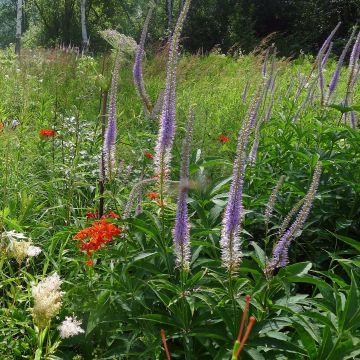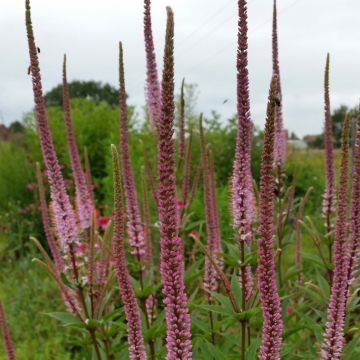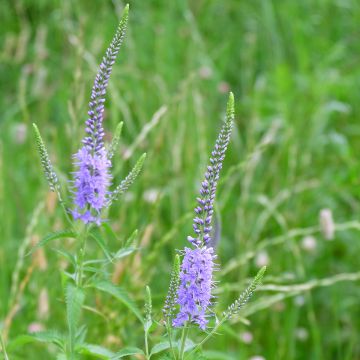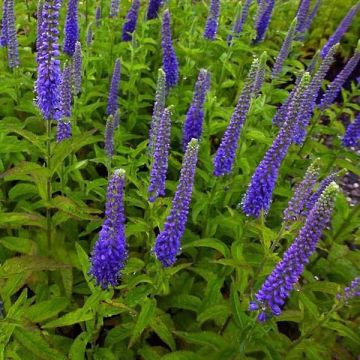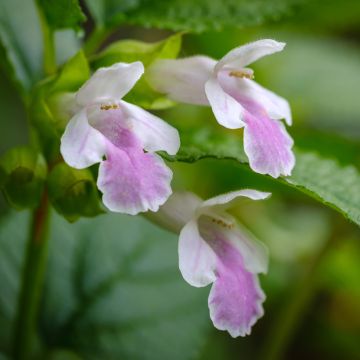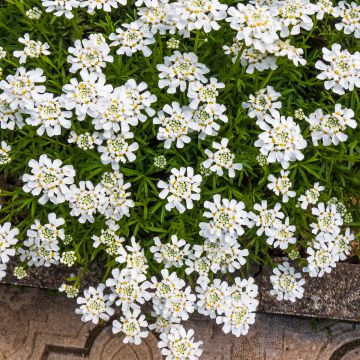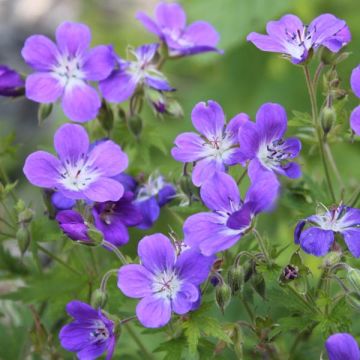

Veronica prostrata Mrs Holt


Veronica prostrata Mrs Holt
Veronica prostrata Mrs Holt
Veronica prostrata Mrs Holt
Prostrate Speedwell, Creeping Speedwell
This item cannot be shipped to the selected country
Delivery charge from €5.90
More information
Schedule delivery date,
and select date in basket
This plant carries a 12 months recovery warranty
More information
We guarantee the quality of our plants for a full growing cycle, and will replace at our expense any plant that fails to recover under normal climatic and planting conditions.
From €5.90 for pickup delivery and €6.90 for home delivery
Express home delivery from €8.90.

Does this plant fit my garden?
Set up your Plantfit profile →
Description
Veronica prostrata 'Mrs Holt' is a delightful form of Veronica prostrata, native to the alpine mountains of Europe. The abundant and pastel flowering of this charming perennial ground cover is a delight in late spring. It bears numerous spikes of small pale lilac-pink star-shaped flowers. More generous in moist soil, it sometimes blooms again during the summer. A very hardy, carefree, and low-maintenance plant. It is perfect for rockeries, borders, and even containers.
Veronica prostrata, also known as Veronica rupestris, is a perennial plant with rooting stems from the Plantaginaceae family. It is native to central and southern Europe where it grows among bushes in meadows and clearings, and on grassy and open embankments. 'Mrs Holt' is an English cultivar appreciated for its pink flowering. It develops by forming numerous prostrate branches spread in a circle. They are upright at the level of the inflorescence, reaching about 10 to 12cm (4 to 5in) in height. Each stem emits roots at the nodes, allowing the plant to cover the ground over an area of at least 30 to 40cm (12 to 16in) in diameter, much more over time. The stem is solid and covered with small white hairs. The light green foliage is evergreen depending on the severity of the winter. It is composed of opposite, fairly elongated, entire leaves, 2.5cm (1in) long and 1cm (0.4in) wide. Both sides of the leaves are pubescent and the leaf edge is often slightly rolled up on itself. In May-June, the plant produces numerous inflorescences in conical clusters of deep pink buds at the end of the upright stems, which open into small light-pink flowers with 4 petals, 0.6cm (0in) in diameter. The flowers first bloom at the base of the spikes, then gradually open up to the top of the inflorescence.
Veronica prostrata 'Mrs Holt' is naturally suited for ornamenting rather grassy rockeries, for example, reconstructed alpine meadows, but also thrives in large sunny embankments. You can plant in ground that is occasionally dry, as it tolerates water shortage quite well. However, dry conditions will affect its floribundity. It will be very useful and beautiful along a pathway, planted en masse and bordered by lady's mantle or silverweed, in a rockery alongside small chamomiles (Chamaemelum nobile, Anthemis tinctoria, Anthemis cretica), or at the edge of a flower bed, in the company of , Globularia repens, Antennaria dioica 'Rubra', Pulsatilla, Teucrium chamaedrys, or even Potentilla nitida.
Report an error about the product description
Veronica prostrata Mrs Holt in pictures




Flowering
Foliage
Plant habit
Botanical data
Veronica
prostrata
Mrs Holt
Scrophulariaceae
Prostrate Speedwell, Creeping Speedwell
Alps
Other Veronica - Speedwell
Planting and care
Plant this creeping variety in any ordinary, well-drained soil, even if acidic, sandy, or slightly calcareous. Place in full sun, or in partial shade in warm climates. While it tolerates summer drought quite well in deep and light soil, it dreads rocky soils and arid situations. Perfect in a rock garden or as a border plant. It will flower more easily with some occasional watering and if one takes care to remove faded flowers. Hardy to -25°C (-13°F).
Planting period
Intended location
Care
-
, onOrder confirmed
Reply from on Promesse de fleurs
Spring flowering perennials
Haven't found what you were looking for?
Hardiness is the lowest winter temperature a plant can endure without suffering serious damage or even dying. However, hardiness is affected by location (a sheltered area, such as a patio), protection (winter cover) and soil type (hardiness is improved by well-drained soil).

Photo Sharing Terms & Conditions
In order to encourage gardeners to interact and share their experiences, Promesse de fleurs offers various media enabling content to be uploaded onto its Site - in particular via the ‘Photo sharing’ module.
The User agrees to refrain from:
- Posting any content that is illegal, prejudicial, insulting, racist, inciteful to hatred, revisionist, contrary to public decency, that infringes on privacy or on the privacy rights of third parties, in particular the publicity rights of persons and goods, intellectual property rights, or the right to privacy.
- Submitting content on behalf of a third party;
- Impersonate the identity of a third party and/or publish any personal information about a third party;
In general, the User undertakes to refrain from any unethical behaviour.
All Content (in particular text, comments, files, images, photos, videos, creative works, etc.), which may be subject to property or intellectual property rights, image or other private rights, shall remain the property of the User, subject to the limited rights granted by the terms of the licence granted by Promesse de fleurs as stated below. Users are at liberty to publish or not to publish such Content on the Site, notably via the ‘Photo Sharing’ facility, and accept that this Content shall be made public and freely accessible, notably on the Internet.
Users further acknowledge, undertake to have ,and guarantee that they hold all necessary rights and permissions to publish such material on the Site, in particular with regard to the legislation in force pertaining to any privacy, property, intellectual property, image, or contractual rights, or rights of any other nature. By publishing such Content on the Site, Users acknowledge accepting full liability as publishers of the Content within the meaning of the law, and grant Promesse de fleurs, free of charge, an inclusive, worldwide licence for the said Content for the entire duration of its publication, including all reproduction, representation, up/downloading, displaying, performing, transmission, and storage rights.
Users also grant permission for their name to be linked to the Content and accept that this link may not always be made available.
By engaging in posting material, Users consent to their Content becoming automatically accessible on the Internet, in particular on other sites and/or blogs and/or web pages of the Promesse de fleurs site, including in particular social pages and the Promesse de fleurs catalogue.
Users may secure the removal of entrusted content free of charge by issuing a simple request via our contact form.
The flowering period indicated on our website applies to countries and regions located in USDA zone 8 (France, the United Kingdom, Ireland, the Netherlands, etc.)
It will vary according to where you live:
- In zones 9 to 10 (Italy, Spain, Greece, etc.), flowering will occur about 2 to 4 weeks earlier.
- In zones 6 to 7 (Germany, Poland, Slovenia, and lower mountainous regions), flowering will be delayed by 2 to 3 weeks.
- In zone 5 (Central Europe, Scandinavia), blooming will be delayed by 3 to 5 weeks.
In temperate climates, pruning of spring-flowering shrubs (forsythia, spireas, etc.) should be done just after flowering.
Pruning of summer-flowering shrubs (Indian Lilac, Perovskia, etc.) can be done in winter or spring.
In cold regions as well as with frost-sensitive plants, avoid pruning too early when severe frosts may still occur.
The planting period indicated on our website applies to countries and regions located in USDA zone 8 (France, United Kingdom, Ireland, Netherlands).
It will vary according to where you live:
- In Mediterranean zones (Marseille, Madrid, Milan, etc.), autumn and winter are the best planting periods.
- In continental zones (Strasbourg, Munich, Vienna, etc.), delay planting by 2 to 3 weeks in spring and bring it forward by 2 to 4 weeks in autumn.
- In mountainous regions (the Alps, Pyrenees, Carpathians, etc.), it is best to plant in late spring (May-June) or late summer (August-September).
The harvesting period indicated on our website applies to countries and regions in USDA zone 8 (France, England, Ireland, the Netherlands).
In colder areas (Scandinavia, Poland, Austria...) fruit and vegetable harvests are likely to be delayed by 3-4 weeks.
In warmer areas (Italy, Spain, Greece, etc.), harvesting will probably take place earlier, depending on weather conditions.
The sowing periods indicated on our website apply to countries and regions within USDA Zone 8 (France, UK, Ireland, Netherlands).
In colder areas (Scandinavia, Poland, Austria...), delay any outdoor sowing by 3-4 weeks, or sow under glass.
In warmer climes (Italy, Spain, Greece, etc.), bring outdoor sowing forward by a few weeks.





































